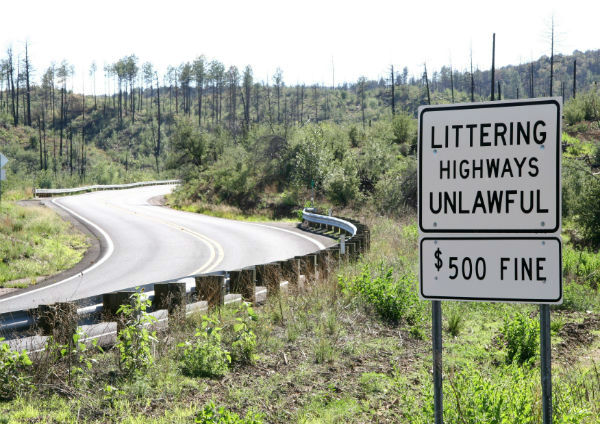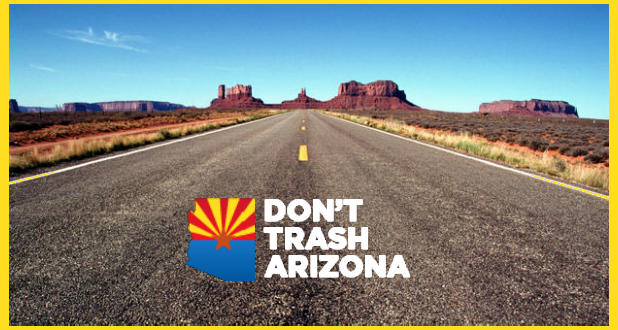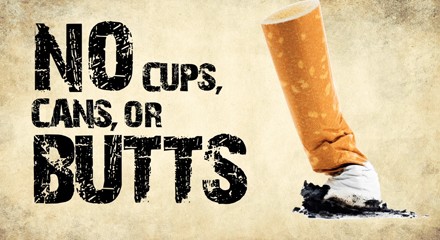
By Emily Powell
In 2006, Arizona Department of Transportation employees collected 500 trash bags’ worth of fast food wrappers, cigarette butts, soda cans and other toxic litter every week from Valley freeways. This trash, thrown from car windows and escaping from flatbed trailers, threatened our community’s environmental, physical and economic health. That year, the Maricopa Association of Governments initiated the “Don’t Trash Arizona” litter education and prevention program, which has since reduced litter on Arizona roads by 50 percent, sustaining community pride in Arizona’s landscape and bringing economic benefit to the Valley.
Phoenix Mayor Greg Stanton attributes the accomplishment to the team’s dedication to getting the message out to the right people at the right time. “The goal of the [Don’t Trash Arizona] program is to change attitudes, awareness and – most importantly – behaviors when it comes to roadway littering,” explains Kelly Taft, communications manager for the Maricopa Association of Governments, an organizing board composed of 32 governing agencies from Maricopa County, Pinal County, Native American communities and the Arizona Department of Transportation. “We have identified through several surveys a target demographic of males ages 18-35, so our campaign is designed to…find the appropriate venues where we will be directly heard by that demographic.” Even so, Taft says, “littering is a complex behavior, and it can be difficult to get that behavior to change…That’s why we also target younger pre-teens and high school students,” before they get their driver’s licenses. “We’re trying to get that message to them before the [littering] behavior starts. It takes time, and it takes money.”

Provided for in Maricopa County by a half-percent sales tax increase approved by voters
in 2004 under Prop 400, the program uses funds to create radio advertising, strategically-placed signage, floor advertising in convenience stores, and occasional TV commercials to reach Arizona drivers. Don’t Trash Arizona representatives also speak at driver training programs such as Ford’s “Driving Skills for Life” to highlight the negative consequences of littering – such as how the wrapper of a $5 fast food hamburger turns into a $500 fine when thrown out the window. Their efforts have revealed impressive results – the volume of litter collected has gone from 1.6 million pounds per year to 788,000 pounds per year in just over a decade.

Ad created for “Don’t Trash Arizona” by Commotion Studios.
This immense reduction, highlights Mayor Stanton, sustains the region’s economy in unexpected ways. “The Mayors and business leaders around the table recognized that litter on our roadways was not just impacting our quality of life, but also our ability to attract tourism and business,” says Mayor Stanton. “For visitors who show up by the thousands this time of year for Spring Training, our freeways make an all-important first impression. We want the world to know that we love our state and our region, and the best way to show that is by keeping our freeways free of trash.” As Tempe Mayor Mark Mitchell adds, “eliminating freeway litter is one way we can keep not only tourists, but businesses, coming back to our state…On the flip side, we want to make sure they keep our state clean when visiting. They will be more inclined to do so if the landscape is already clean.”
Reducing roadway litter also proves to support clean, healthy, safe communities and ecosystems. As Taft points out, toxic chemicals from decomposing waste like cigarettes can pollute our water system, leading to widespread damage on biodiversity and water safety. Large debris littered on the freeway also causes accidents which lead to about 125 deaths a year nationwide. “It’s ugly, unhealthy and unsafe,” she emphasizes. In order to alleviate the damage, “we’re just asking you to keep litter inside your vehicle until you can dispose of it or recycle it properly.”
“We all know Arizona has a stunning landscape, with picturesque mountains and gorgeous sunsets, which is why it is important to keep litter from cluttering the view,” says Arizona Office of Tourism Deputy Director Stephanie Dowling. The progress made through the Don’t Trash Arizona program is astronomical compared to most other litter prevention programs across the nation. As Taft recalls, “I was told it takes about seven years to see improvement [in litter reduction].” The accomplishments thus far are impressive, but not enough: “There is more work to do. We want to continue this trend so that we can continue to market our state as one of pristine beauty,” says Mayor Stanton.
As Taft concludes, “more people are recognizing the tremendous beauty of our state and the importance to our health, our environment, and our economy of just keeping that litter in their car. We intend to keep this momentum going.”
For more information and to report littering incidents, visit DontTrashArizona.com.






